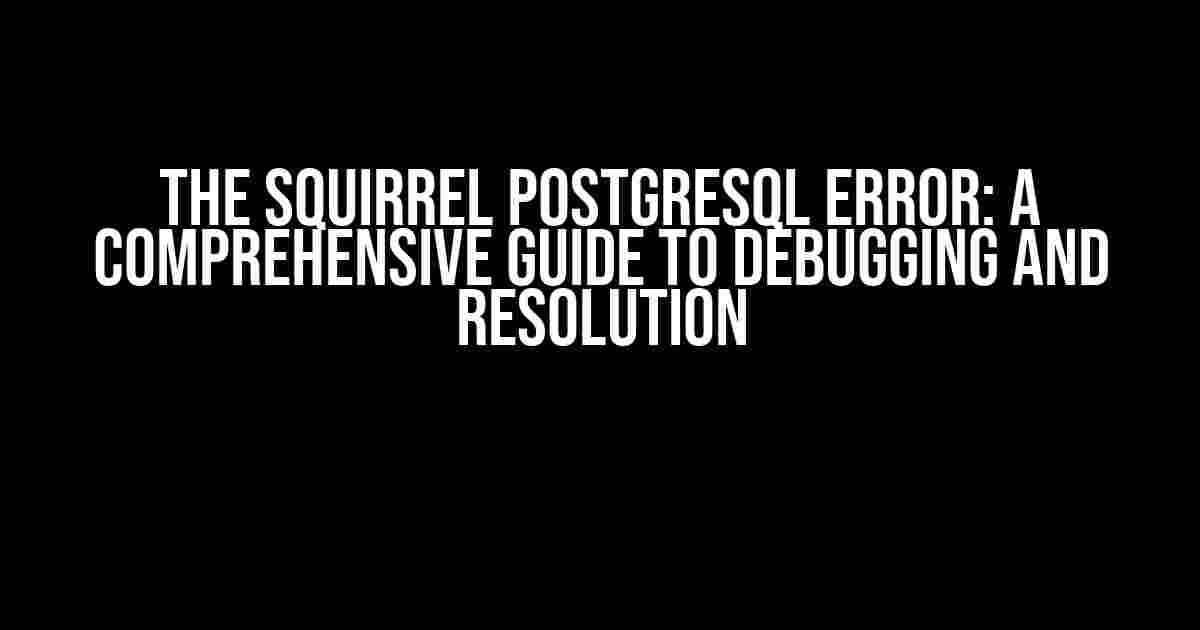Are you tired of encountering the frustrating “syntax error at or near ‘,'” error in your PostgreSQL database? You’re not alone! This pesky error can bring your workflow to a grinding halt, but fear not, dear reader, for we’re about to embark on a journey to conquer this beast once and for all.
Understanding the Error: What’s Going On?
The “syntax error at or near ‘,'” error typically occurs when there’s an issue with the SQL syntax in your query. Yes, you read that right – it’s not a PostgreSQL-specific problem, but rather a SQL syntax issue. This error can manifest in various ways, such as:
- Missing or misplaced commas
- Invalid data types
- Incorrect usage of quotes
- Unclosed parentheses or brackets
So, what’s the deal with the comma (“,”) specifically? Well, in SQL, commas are used to separate values, columns, or expressions. When PostgreSQL encounters a comma in the wrong place, it throws a syntax error, indicating that something’s amiss.
Common Scenarios that Trigger the Error
Let’s explore some common scenarios that can trigger the “syntax error at or near ‘,'” error:
Scenario 1: Missing Comma in the VALUES Clause
INSERT INTO customers (name, email, phone)
VALUES ('John Doe', '[email protected]' '123-456-7890');
In this example, the comma is missing between the email and phone values, causing the error.
Scenario 2: Incorrect Use of Quotes
SELECT * FROM customers WHERE name = 'John Doe', 'Jane Doe';
This query attempts to use commas to separate values in the WHERE clause, which is incorrect. Instead, use the IN operator or separate OR conditions.
Scenario 3: Unclosed Parentheses
SELECT * FROM customers WHERE (name = 'John Doe' AND age > 25;
The opening parenthesis is not closed, leading to a syntax error.
Debugging Techniques to Identify the Issue
To debug the error, follow these steps:
-
Check the query for any obvious syntax errors, such as missing or misplaced commas, quotes, or parentheses.
-
Verify that the data types match the column definitions in the table.
-
Use the PostgreSQL built-in function
pg_last_error()to retrieve the error message and analyze it. -
Try breaking down the query into smaller, more manageable pieces to isolate the problematic section.
Resolving the Error: A Step-by-Step Guide
Now that we’ve identified the common scenarios and debugging techniques, let’s walk through the resolution process:
Step 1: Review the Query Syntax
Go through the query and verify that:
- Commas are used correctly to separate values, columns, or expressions.
- Quotes are used correctly to enclose string values.
- Parentheses and brackets are balanced and closed correctly.
Step 2: Verify Data Types
Check that the data types in the query match the column definitions in the table. For example:
| Column | Data Type |
|---|---|
| name | varchar(50) |
| varchar(100) | |
| phone | varchar(20) |
Step 3: Test the Query
Execute the query in a PostgreSQL client, such as psql or pgAdmin, to verify that the error is resolved.
Best Practices to Avoid the Error
To avoid encountering the “syntax error at or near ‘,'” error in the future, follow these best practices:
- Use an IDE or text editor with syntax highlighting to catch errors early.
- Test queries in a development environment before deploying to production.
- Use parameterized queries to avoid SQL injection vulnerabilities.
- Follow a consistent coding style and formatting convention.
In conclusion, the “syntax error at or near ‘,'” error in PostgreSQL is a common issue that can be resolved by understanding the underlying causes, using debugging techniques, and following best practices. By following this comprehensive guide, you’ll be well-equipped to tackle this error and ensure smooth sailing in your database endeavors.
If you’re still struggling with the error, don’t hesitate to reach out to the PostgreSQL community or seek help from a seasoned database administrator. Happy debugging!
Frequently Asked Question
We’ve got the answers to your burning questions about that pesky Postgres error!
What is the “syntax error at or near ‘,'” error in Postgres?
This error typically occurs when there’s a mismatch in the number of columns in your SELECT statement and the number of columns in your INSERT statement. It can also happen if you’re using a comma (,) in the wrong place or forgetting a comma where it’s needed. Double-check your query and make sure everything is properly aligned!
How can I identify the exact location of the error in my query?
Postgres provides a helpful error message that usually points to the location of the error. Look for the “syntax error at or near” phrase, followed by the problematic character (in this case, the comma). You can also try highlighting the problematic area of your query to see if that helps you spot the issue.
Can I use a comma after the last column in my SELECT statement?
Nope! In Postgres, you shouldn’t use a comma after the last column in your SELECT statement. This is a common mistake that can trigger the “syntax error at or near ‘,'” error. Remove the extra comma, and your query should be good to go!
What if I’m using a CSV file to import data into Postgres?
When importing data from a CSV file, make sure your file is properly formatted, with each column separated by a comma (and only one comma per separation!). Also, ensure that your COPY command matches the number of columns in your CSV file. If you’re still stuck, try using the \copy command instead, which can be more forgiving.
How can I avoid this error in the future?
To avoid this error, always double-check your queries for typos, missing commas, and mismatched columns. Use a code editor with syntax highlighting to help you spot potential issues. And, of course, test your queries in a development environment before running them in production!



